The Grey Francolin (Francolinus pondicerianus) symbolizes resilience and adaptability in the avian world. This ground-dwelling bird captivates birdwatchers and researchers with its earthy plumage and distinctive calls resonating across open fields.
The Grey Francolin, also known as the “grey partridge” or “teetar,” belongs to the family Phasianidae and is native to the Indian subcontinent and parts of Iran and Afghanistan.
Its cryptic coloration allows it to blend seamlessly into its surroundings, providing camouflage from predators and human observers.
Despite its unassuming appearance, the Grey Francolin possesses a rich cultural significance, prominently featured in folklore, poetry, and traditional hunting practices across its range.
In recent years, however, habitat loss and fragmentation have posed significant threats to its survival, underscoring the importance of conservation efforts to protect this charismatic species. Join us to explore the enchanting world of the Grey Francolin.
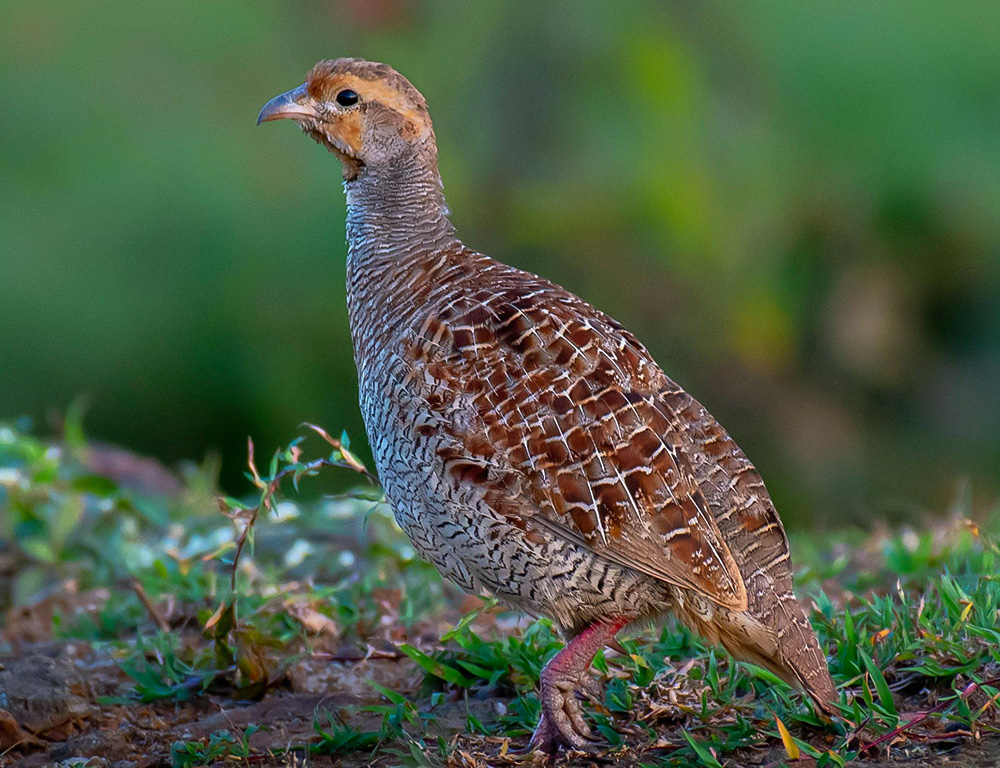
What Are the Identifying Characteristics of the Grey Francolin?
The Grey Francolin, with its muted grey-brown plumage intricately patterned with darker streaks and markings, blends seamlessly into its grassland and agricultural habitats.
Its compact, plump body, short rounded wings, and relatively long tail give it a distinctive silhouette as it forages and moves across the ground.
Despite its cryptic appearance, the Grey Francolin’s vocalizations are unmistakable—a series of loud, repetitive calls that resonate across open fields and scrublands, serving as territorial markers and communication signals.
Habitat Preference
The Grey Francolin inhabits various open habitats, including grasslands, agricultural fields, scrublands, and lightly wooded areas. It prefers areas with dense vegetation for cover and nesting while also requiring access to open spaces for foraging.
Foraging Behavior
Grey Francolins primarily forage on the ground as ground-dwelling birds, using their strong legs and feet to scratch and probe for seeds, insects, small vertebrates, and plant matter.
They may also feed on grains and crops, making them occasional pests for farmers.
Vocalizations
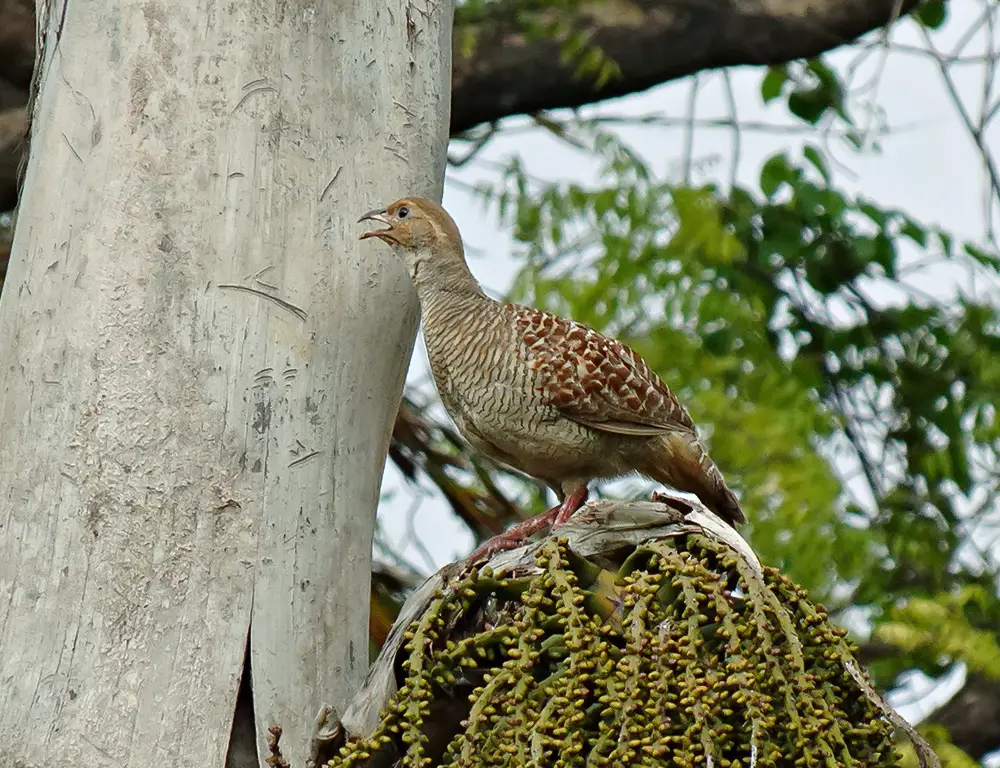
One of the Grey Francolin’s most distinguishing features is its vocal repertoire. Males are particularly vocal during the breeding season, emitting a series of loud, repetitive calls that attract mates and establish territories.
These calls vary in intensity and frequency and can be heard throughout the day, especially during the early morning and late evening.
Social Structure
Grey Francolins are typically seen in pairs or small family groups, although larger gatherings may occur in areas with abundant food resources or during the breeding season.
They are generally territorial birds, with males defending their territories through vocal displays and occasional physical confrontations with intruders.
Camouflage and Defense
The Grey Francolin’s cryptic plumage effectively camouflages it against predators, allowing it to blend into its surroundings and avoid detection.
When threatened, it may freeze in place or crouch low to the ground, relying on its camouflage to evade predators.
It may take flight with a burst of rapid wingbeats, seeking refuge in nearby cover if pursued.
Flight Characteristics
While primarily ground-dwelling, Grey Francolins are capable of short, rapid flights when necessary. Their flight is characterized by quick, whirring wingbeats and low, darting movements, often followed by a swift descent back to the ground.
Despite their relatively weak flying abilities, they can navigate through dense vegetation with agility and precision.
Seasonal Movements
Grey Francolins may exhibit seasonal movements in response to changes in food availability, habitat conditions, and breeding requirements.
While some populations are sedentary, others may undertake localized movements or dispersals for suitable nesting sites or foraging opportunities.
Taxonomy, Distribution, and Breeding Habits of the Grey Francolin
Delve into the nesting habits of the Grey Francolin, a ground-dwelling bird native to South Asia. From constructing its nest to incubating its eggs, discover the fascinating details of this species’ breeding behavior.
Taxonomy of the Grey Francolin
| Taxonomy Level | Classification |
| Kingdom | Animalia |
| Phylum | Chordata |
| Class | Aves |
| Order | Galliformes |
| Family | Phasianidae |
| Genus | Francolinus |
| Species | Francolinus pondicerianus |
Range Map
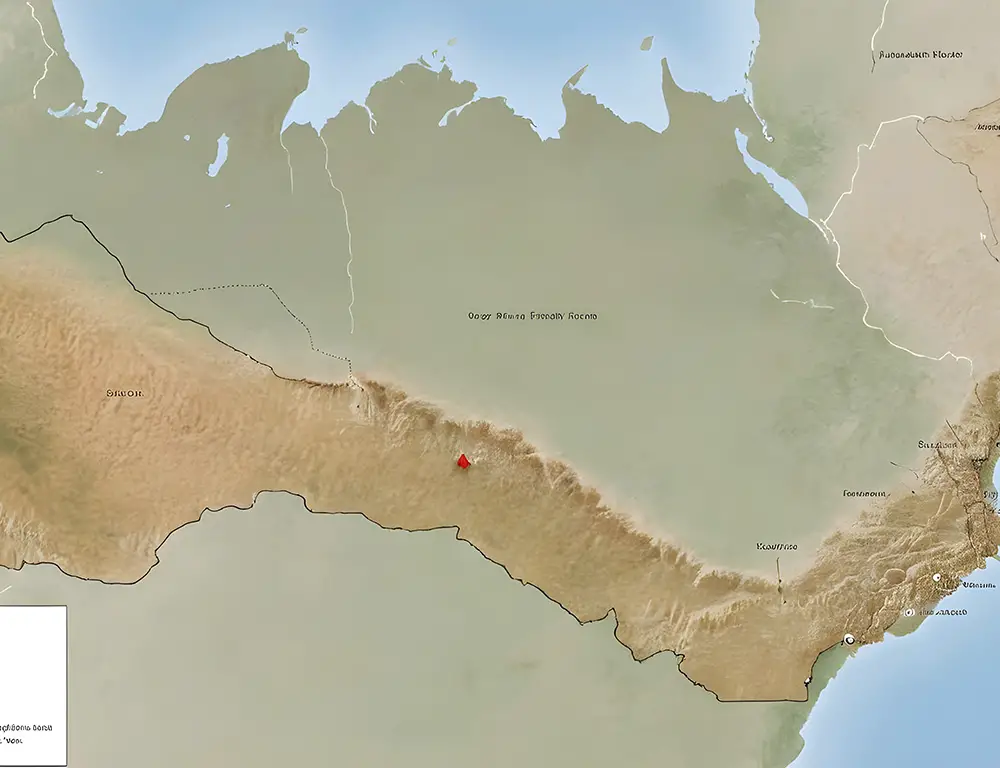
The Grey Francolin (Francolinus pondicerianus) is native to South Asia, including India, Pakistan, Nepal, Bangladesh, and Sri Lanka.
Its distribution extends across various habitats, ranging from grasslands and agricultural fields to scrublands and lightly wooded areas. The species may also occur in urban and suburban environments where suitable habitat is available.
Food Habits
Grey Francolins are omnivorous, feeding on various seeds, grains, insects, small vertebrates, and plant matter. Their diet varies seasonally and regionally, depending on food availability and habitat characteristics.
They may opportunistically feed on crops, making them occasional pests for farmers.
Nesting
Grey Francolins typically construct ground scrapes for nesting, which are shallow depressions lined with grass, leaves, and sometimes feathers for insulation.
These nests are commonly found in open grasslands, agricultural fields, and scrublands. The clutch size typically ranges from 6 to 12 eggs, although it can vary based on food availability and habitat quality.
The female primarily incubates for approximately three weeks until the eggs hatch. Once hatched, both parents care for the chicks until they are ready to fledge.
| Feature | Description |
| Features | Ground-nesting bird |
| Nest Type | Ground scrape |
| Nest Location | Open grasslands, agricultural fields |
| Materials Used | Grass, leaves, feathers |
| Clutch Size | 6 to 12 eggs |
| Incubation Period | Approximately 3 weeks |
Breeding
Breeding in Grey Francolins typically occurs during the monsoon season, with peak activity observed from June to September. Males are highly vocal during this time, emitting loud calls to attract mates and establish territories.
Courtship displays may include strutting, wing-fluttering, and vocalizations. After mating, the female lays a clutch of eggs in the nest, where she incubates them for about three weeks until hatching.
Both parents may share incubation duties and participate in chick rearing after hatching.
Conservation Status
The Grey Francolin is considered a species of most minor concern (LC), according to the International Union for Conservation of Nature (IUCN) Red List.
While it is widely distributed across its range and can adapt to various habitats, populations may face threats such as habitat loss, hunting pressure, and pesticide exposure in agricultural areas.
Continued monitoring and conservation efforts are essential to ensure the long-term viability of Grey Francolin populations across South Asia.
What Are the Common Diseases and Treatments of the Grey Francolin?
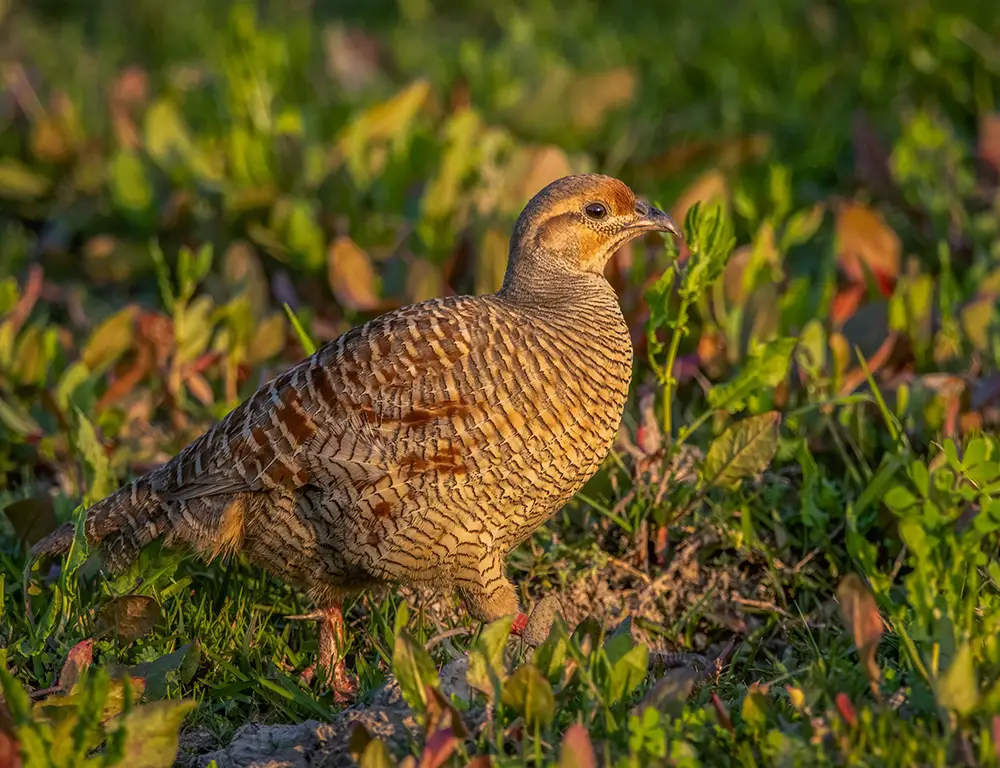
As caretakers of Grey Francolins, it’s crucial to be aware of the potential health issues they may face. By recognizing common diseases and implementing appropriate treatments, we can ensure the health and vitality of these captivating birds.
Avian Pox
Avian pox is a viral disease that can affect Grey Francolins, causing wart-like growths on the skin, mucous membranes, and internal organs.
Treatment involves supportive care to alleviate symptoms and prevent secondary infections. Vaccination may also be utilized in captive populations to prevent the spread of the virus.
Aspergillosis
Aspergillosis is a fungal infection caused by the Aspergillus fungus that can affect Grey Francolins’ respiratory systems. Symptoms include difficulty breathing, lethargy, and nasal discharge.
Treatment involves antifungal medications administered orally, topically, or via nebulization. Environmental management, including maintaining clean and dry enclosures, is crucial for preventing the spread of Aspergillus spores.
Parasitic Infections
Grey Francolins are susceptible to various parasitic infections, including internal parasites such as worms and external parasites such as mites and lice. These parasites can cause gastrointestinal issues, feather damage, and skin irritation.
Treatment may involve antiparasitic medications administered orally, topically, or via injection. Preventative measures, such as regular parasite screenings and maintaining clean living environments, are essential for controlling parasite infestations.
Nutritional Deficiencies
Improper diet and inadequate nutrition can lead to nutritional deficiencies in Grey Francolins, affecting their overall health and reproductive success. Common deficiencies include vitamin A, calcium, and protein.
Treatment involves correcting the diet to provide essential nutrients through supplementation or dietary modifications.
Regular monitoring of nutritional status and consultation with avian nutrition specialists are essential for preventing and addressing nutritional deficiencies in captive populations.
Bacterial Infections
Grey Francolins are susceptible to various bacterial infections, including Salmonella and E. coli. These infections can cause gastrointestinal issues, respiratory problems, and systemic illness.
Treatment involves antimicrobial medications targeted at specific pathogens and supportive care to manage symptoms and prevent transmission.
Preventative measures, such as strict biosecurity protocols and routine health screenings, are essential for reducing the risk of bacterial infections in captive and wild populations.
7 Interesting Facts About the Grey Francolin
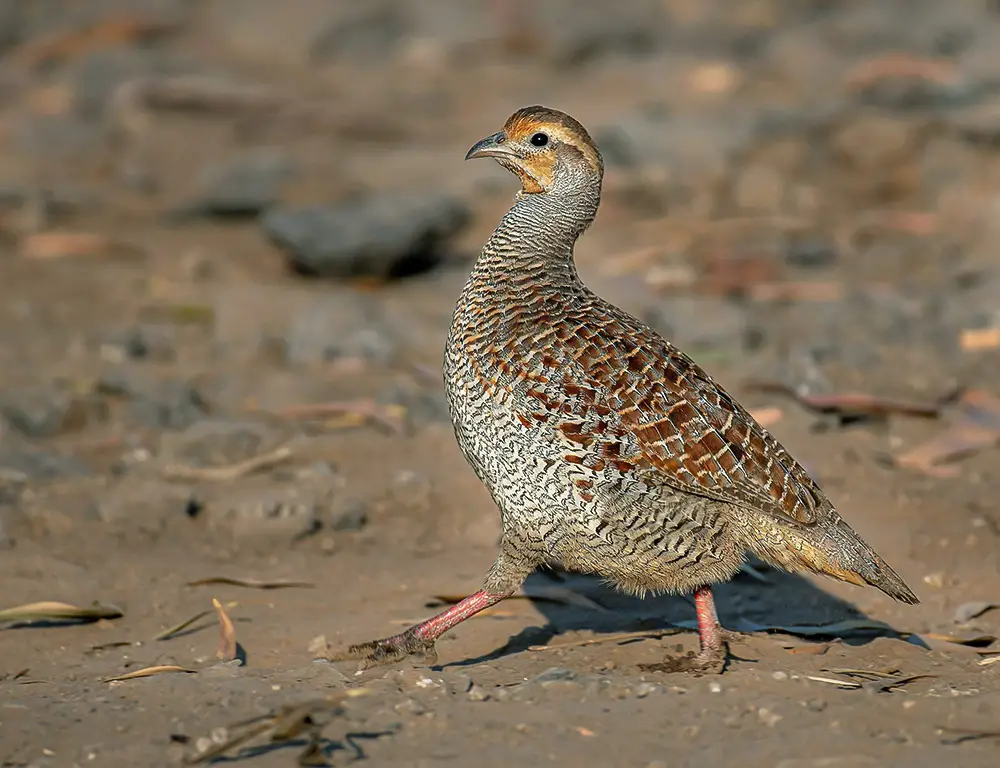
Uncover the intriguing world of the Grey Francolin, a ground-dwelling bird native to South Asia. Explore these captivating facts about one of the region’s iconic avian species, from its cryptic plumage to its unique behaviors.
1. Cryptic Plumage
The Grey Francolin’s muted grey-brown plumage, intricately patterned with darker streaks and markings, effectively camouflages it against its grassland and agricultural habitats, allowing it to blend seamlessly into its surroundings and evade predators.
2. Distinctive Calls
Males are known for loud, repetitive calls that resonate across open fields and scrublands during the breeding season. These calls serve as territorial markers and communication signals, attracting mates and establishing dominance within their territories.
3. Ground-Dwelling Behavior
Grey Francolins are primarily ground-dwelling birds, foraging for seeds, insects, and small vertebrates among the vegetation and leaf litter. Their strong legs and feet are well-adapted for scratching and probing the forest floor for food.
4. Cooperative Breeding
In some populations, Grey Francolins exhibit cooperative breeding behavior, with individuals from the same family group assisting in raising the young.
This cooperative effort helps improve the chicks’ chances of survival and reinforces social bonds within the group.
5. Seasonal Movements
While primarily sedentary, Grey Francolins may undertake localized movements or dispersals in response to changes in food availability, habitat conditions, and breeding requirements.
These seasonal movements contribute to the species’ adaptability and resilience across its range.
6. Cultural Significance
The Grey Francolin holds cultural significance in South Asia, prominently featured in folklore, poetry, and traditional hunting practices. Its calls and presence in the landscape have inspired countless stories and legends, enriching the region’s cultural heritage.
7. Habitat Loss Threats
Despite its adaptability, the Grey Francolin faces habitat loss and degradation threats due to agricultural expansion, urbanization, and land-use changes.
Conservation efforts aimed at preserving and restoring its native habitats are essential for ensuring the long-term survival of this iconic species.
FAQs
How does the Grey Francolin protect itself from predators?
The Grey Francolin relies on its cryptic plumage to blend into its surroundings, providing camouflage from predators. When threatened, it may freeze in place or crouch low to the ground, relying on its camouflage to evade detection.
Does the Grey Francolin migrate?
Grey Francolins are primarily sedentary birds, meaning they do not undertake long-distance migrations.
However, some populations may exhibit localized movements or dispersals in response to changes in food availability, habitat conditions, and breeding requirements.
How does breeding occur in Grey Francolins?
Breeding in Grey Francolins typically occurs during the monsoon season, with peak activity observed from June to September. Males become highly vocal, loudly calling to attract mates and establish territories.
What is the lifespan of a Grey Francolin?
Grey Francolins’ lifespan in the wild is typically around 2 to 3 years, although some individuals may live longer under favorable conditions. They may live slightly longer in captivity with proper care and management.
How does habitat loss affect Grey Francolin populations?
Habitat loss and degradation due to agricultural expansion, urbanization, and land-use changes pose significant threats to Grey Francolin populations.
Loss of suitable habitat reduces breeding and foraging opportunities, leading to declines in population numbers and genetic diversity.
Conclusion
The Grey Francolin emerges as a remarkable testament to the resilience and adaptability of avian life in the diverse landscapes of South Asia.
With its cryptic plumage and distinctive calls echoing across grasslands and agricultural fields, this ground-dwelling bird has carved out a niche in natural ecosystems and human culture.
As we reflect on the challenges facing the Grey Francolin, including habitat loss and fragmentation, it becomes clear that concerted conservation efforts are essential to ensure its continued survival.
By preserving and restoring its native habitats, implementing sustainable land management practices, and raising awareness about the importance of protecting this iconic species, we can safeguard its future for future generations.
So, let us embrace the spirit of stewardship and appreciation for the natural world, recognizing the Grey Francolin as a symbol of resilience and biodiversity in our shared landscape.